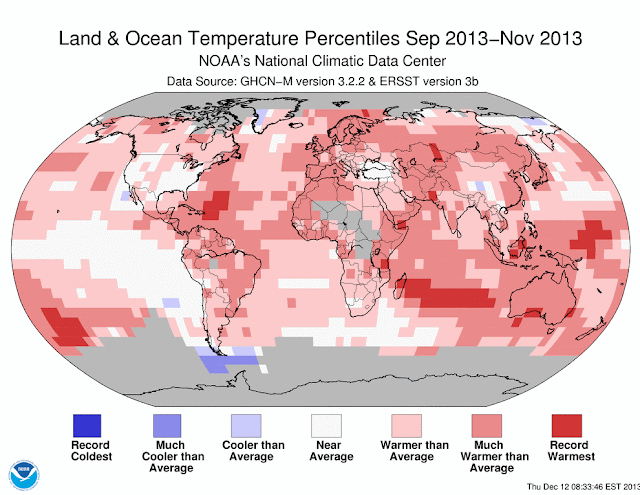(Updated 7 Jan 2014) Sea surface temperatures around Australia in 2013 were unusually warm reported the Australian Bureau of Meteorology in it's annual climate statement. Record ocean temperatures were recorded for January and February, with November the second-highest on record. This continues a long term trend for increasing sea surface temperatures around Australia and globally.

The report stated:
Preliminary data, for the year to November, place SSTs for 2013 as the third-highest since 1910, 0.51 °C above the long-term average. Below-average annual SSTs have not been recorded for the Australian region since 1994; the region has seen a total rise in SSTs of approximately 1 °C since 1910, a similar value to that recorded for atmospheric warming over land.
SSTs were consistently very much above average off the western and southern coast of Australia from summer 2012-13 until May. Strong warm anomalies continued in waters to the south of the mainland throughout 2013. For the year to November, SSTs in the southern region were some 0.59 °C above average, surpassing the annual record (+0.56 °C in 1999) by 0.03 °C.
Professor Roger Jones, a Professorial Research Fellow at the Centre for Strategic Economic Studies at Victoria University and a Convening Lead Author (CLA) on the Intergovernmental Panel on Climate Change's Working Group II Fifth Assessment Report to be released later this year commented on sea surface temperatures:
"The consistently high sea surface temperatures around Australia mean that hotter conditions will continue. They will also contribute to a vigorous hydrological cycle, which can often manifest in greater extremes of rainfall, particularly in northern Australia. This vigour was reflected in a number of flooding events around the nation."
This sustained recent period of record high Sea surface temperatures extends from 2010, although you can see on the graph above the clear trend going back to the start of accurate records in 1910.
Roger Jones blogged specifically on the Western Australian sea surface temperatures. Here is some of what he had to say:
NOAA reported record global sea surface temperatures in August. The November 2013 NOAA National Climatic Data center global analysis report stated:
"Globally, the average ocean temperature for September-November was the fourth highest on record for the period, at 0.58°C (1.04°F) above average. As indicated by the Land & Ocean Temperature Percentiles map, very few regions were below average, most notably the Southern Ocean off the tip of South America. Many areas were much warmer than average, with sections of the eastern Atlantic, parts of the south central and southeast Indian Ocean, and parts of the south central and western equatorial Pacific Ocean observing record warmth."
Elevated SST impacts: Stronger storms, migrating fisheries, coral bleaching
While elevated sea surface temperatures (SST) may not cause an increase in frequency of tropical cyclones as a number of factors need to come together for their formation, higher sea surface temperatures are known to add energy to storms increasing the intensity of tropical cyclones and typhoons.
Elevated SST contributed to Typhoon Usagi, Typhoon Haiyan that impacted the Philippines and Asia, and ex-cyclone Oswald that brought extreme torrential rain to the Queensland and northern NSW coasts causing extensive flooding and destruction in January 2013.
In October tropical cyclone Phailan formed in the warm waters of the Bay of Bengal, the strongest cyclone ever measured in the Indian Ocean according to US meteorologist Eric Holthaus. It's rapid intensification was aided by ocean surface temperatures in the Bay of Bengal that were warmer than 28 degrees Celsius (82.4 degrees Fahrenheit), which is "about as warm as ocean water can get," Holthaus said, according to a livescience report. Widespead warnings and evacuation of hundreds of thousands of people from coastal areas avoided large loss of life, though causing extensive flooding and damage to coastal areas.
Higher water temperatures are also driving fish species to greater depths or higher latitudes. Scientists have identified that fish are migrating to cooler waters. Elevated sea surface temperatures such as the 2010/2011 extreme marine heat wave of the coast of Western Australia have a large impact on marine ecosystems. These events also exacerbate the velocity of climate change for many marine species.
Marine scientists have warned repeatedly that Global Warming imperils coral reefs: 2 degrees warming is too hot. Higher sea surface temperatures will cause coral bleaching and a collapse of the sensitive coral ecosystem and marine diversity.
Coral reefs are already under pressure due to agricultural nutrient pollution, coastal development and destruction of coastal wetlands.
Sources:
- NOAA National Climatic Data Center, State of the Climate: Global Analysis for November 2013, published online December 2013, retrieved on January 4, 2014 from http://www.ncdc.noaa.gov/sotc/global/2013/11
- Australian Bureau of Meteorology Annual climate statement 2013, issued 3 January 2014




